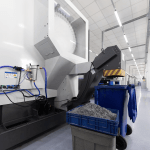 Researchers have proven how quality debris are fashioned from herbal materials in the surroundings.these findings will enhance our know-how about clouds inside the pre-business technology and as a result will make contributions to a extra accurate know-how of both the beyond and future evolution of our weather.
Researchers have proven how quality debris are fashioned from herbal materials in the surroundings.these findings will enhance our know-how about clouds inside the pre-business technology and as a result will make contributions to a extra accurate know-how of both the beyond and future evolution of our weather.
A prerequisite for knowledge how weather has changed over the past centuries is the potential to reconstruct as reliably as viable pre-commercial climatic situations. An essential contribution has now been made with the aid of a comprehensive studies collaboration with contributors at CERN, the Paul Scherrer Institute PSI, and severa other clinical establishments around the arena. The researchers investigated the formation of aerosol debris in the ecosystem. Aerosol debris are vital for climate due to the fact water droplets shape on those debris, resulting in clouds. Aerosol debris are not handiest directly generated —for example, from soot produced via burning timber or by means of vehicle site visitors — but can alsobe formed in the ecosystem from gasoline section precursors. It have been notion that the presence of sulfuric acid became necessary for this latter method, and that consequently this mechanism only becameapplicable with industrialisation. Now the researchers have shown that aerosol debris may be shaped from precursor gases that are emitted via timber. thus these herbal materials had been producing the seeds of clouds from time immemorial. these findings are based totally on experiments in the CLOUD chamber at CERN, wherein a variety of atmospheric conditions can be very specifically replicated. further, parallelresearch at the Jungfraujoch excessive Altitude studies Station within the Swiss Alps verify that thesestrategies do take vicinity in this manner in the actual atmosphere. The results are supplied thru the coordinated ebook of 3 articles in distinguished scientific journals — in Nature and one in technological know-how.
to evaluate the impact of human hobby on weather, scientists ought to be able to evaluate latestweather with that of the pre-industrial era. One essential element of this attempt is to reconstruct the abundance and homes of clouds. This matters because clouds can replicate sunlight and accordingly, to a sure volume, masks the warming of Earth due to greenhouse gases. In turn, the formation of clouds is essentially decided with the aid of aerosol debris inside the air on which water can condense to shapecloud droplets. If extra debris are to be had, more droplets can form, and that modifications the traits of the clouds. Aerosol particles have a selection of sources — ranging for instance from desert dirt to sootparticles produced by means of burning wooden or fossil fuels. in addition, aerosol debris may befashioned inside the environment through a manner called nucleation, while fuel molecules be part ofcollectively. thus far, it become thought that this method become crucially depending on sulfuric acid, which has simplest been present in massive quantities within the ecosystem since the beginning of the industrialisation.
Aerosols from nature
we have now been capable to reveal that aerosol particles able to seeding clouds also can stand up fromnatural materials, consisting of the ones which are emitted with the aid of timber, explainsu.s.Baltensperger — head of the Laboratory for Atmospheric Chemistry at the Paul Scherrer Institute PSI and co-initiator of the project — who this 12 months became honoured with the Spiers Memorial Award of the Royal Society of Chemistry for his studies on aerosols within the surroundings. which means that evenbefore the industrialisation aerosol particles have been fashioned from gaseous precursors inside theenvironment — ensuing in better concentrations than had previously been assumed.
this does not necessarily imply that there were extra clouds in the ones days than previously thought,provides PSI researcher Jasmin Tröstl. however the clouds probably consisted of more and smaller droplets, so that they had been brighter and meditated greater sunlight returned to area. thoseconsequences had been received within the framework of an extensive worldwide researchcollaboration underneath the leadership of researchers at CERN and the PSI. The researchers executedtheir experiments inside the CLOUD chamber at CERN and at the Jungfraujoch high Altitude studiesStation inside the Swiss Alps. The CLOUD chamber is a cylindrical vessel, four.3 metres high and threemetres in diameter, in which a variety of atmospheric conditions can be very in particular replicated. The researchers added the substance pinene, which is emitted via timber, and had been able to have a look at how aerosol particles fashioned in the CLOUD chamber.
Aerosol formation in two stages
We also characterised these strategies with the assist of mathematical models, via which we canunderstand how these debris are formed, Tröstl explains. All in all, it is a completely complicatedprocess. First the pinene molecules are altered through reactions with oxidants inclusive of ozone, and a large number of similar however nonetheless one of a kind molecules — with various stages of ‘stickiness’ — are created. The stickiest, those that bind especially properly with other molecules, can be a part of together to form tiny particles. that is the primary important step, because until the particlesreach a minimal length of around 1.7 nanometres, they truly evaporate again. With this, although, they’restill too small to function the seeds of cloud droplets; for that, they need to be more or less 50 to a hundrednanometres in size. so as for the particles to grow similarly, greater molecules want to condense onto them- and this increasingly includes also the less sticky ones which connect more without difficulty tolarger debris and are found in extra quantities, Tröstl says. those consequences are the most vital so far through the CLOUD test at CERN, stresses CERN researcher Jasper Kirkby, spokesperson of the CLOUDexperiment. when the nucleation and growth of natural biogenic aerosol debris is included in climatemodels, it have to sharpen our know-how of the effect of human sports on clouds and weather.
the 2 steps within the formation of recent aerosol debris are described within the pair of articles in Nature. CERN researcher Jasper Kirkby is first author of the first Nature article; PSI researcher Jasmin Tröstl is firstwriter of the second.
Aerosols excessive within the mountains
additionally, the researchers investigated aerosol particle formation beneath actual atmosphericconditions at the Jungfraujoch high Altitude studies Station. situated at greater than 3500 meters above sea stage, this station lies above the lowest layer of the atmosphere — the planetary boundary layer. Aerosol debris from the planetary boundary layer also can be discovered at this altitude, because they may be carried up with the rising air. moreover, newly fashioned particles can be located here, whosebeginning became inexplicable — till now. clearly, in evaluation to the test at CERN, we could not restrictourselves to at least one individual substance as the precursor for the aerosol particles, explains Federico Bianchi, who took part on this task in the course of his time as a researcher on the PSI and now works at the university of Helsinki. within the system, we found for the primary time in a natural putting the formation of aerosol particles from sulfuric acid and ammonia. extra importantly, we also have beencapable of look at the formation of recent aerosol particles from in basic terms natural materials.consequently the effects of the CLOUD chamber and Jungfraujoch measurements agree in showing that aerosol particles are certainly fashioned from in simple terms organic precursors.
incidentally, Bianchi adds, we may want to best take a look at aerosol formation at the Jungfraujoch atcertain times, because the precursor molecules additionally come out of the lower atmospheric layers, and it appears that the situations for this aerosol formation are most effective beneficial within a time window of round two days following their ascent out of the planetary boundary layer.
Bianchi is first author of the paper in technological know-how, which offers the effects of the Jungfraujochresearch.
Synergies between laboratory and subject
The researchers used the same contraptions for the observations on the Jungfraujoch and for the measurements in the CLOUD chamber. The heart of the gadget is a mass spectrometer — a complicatedpiece of equipment with which many hundreds of various chemical substances may be distinguishedfrom every other. The tool used become synthetic by using the Swiss corporation TOFWERK AG in Thun. This system made it possible to decide the chemical composition in a count number of seconds, Bianchi says.
The courses additionally show how crucial it’s miles to hyperlink laboratory and discipline experiments. Measurements inside the lab allow for certain investigations of person mechanisms, however simplest aarea test can provide information approximately whether or not this manner is applicable within theactual environment. And, says united statesBaltensperger, the Jungfraujoch is one of the fine websitesglobal to look at this type of system within the actual unfastened troposphere, thanks to its place, thesmooth air, and its infrastructure.
story source:
The above submit is reprinted from substances furnished by using Paul Scherrer Institut (PSI). observe:substances can be edited for content material and length.
journal References:
Jasper Kirkby, Jonathan Duplissy, Kamalika Sengupta, Carla Frege, Hamish Gordon, Christina Williamson, Martin Heinritzi, Mario Simon, Chao Yan, João Almeida, Jasmin Tröstl, Tuomo Nieminen, Ismael ok. Ortega, Robert Wagner, Alexey Adamov, Antonio Amorim, Anne-Kathrin Bernhammer, Federico Bianchi, Martin Breitenlechner, Sophia Brilke, Xuemeng Chen, Jill Craven, Antonio Dias, Sebastian Ehrhart, Richard C. Flagan, Alessandro Franchin, Claudia Fuchs, Roberto Guida, Jani Hakala, Christopher R. Hoyle, Tuija Jokinen, Heikki Junninen, Juha Kangasluoma, Jaeseok Kim, Manuel Krapf, Andreas kürten, Ari Laaksonen, Katrianne Lehtipalo, Vladimir Makhmutov, Serge Mathot, Ugo Molteni, Antti Onnela, Otso in line withäkylä, Felix Piel, Tuukka petäjä, Arnaud P. Praplan, Kirsty Pringle, Alexandru Rap, Nigel A. D. Richards, Ilona Riipinen, Matti P. Rissanen, Linda Rondo, Nina Sarnela, Siegfried Schobesberger, Catherine E. Scott, John H. Seinfeld, Mikko Sipilä, Gerhard Steiner, Yuri Stozhkov, Frank Stratmann, Antonio Tomé, Annele Virtanen, Alexander L. Vogel, Andrea C. Wagner, Paul E. Wagner, Ernest Weingartner, Daniela Wimmer, Paul M. Winkler, Penglin Ye, Xuan Zhang, Armin Hansel, Josef Dommen, Neil M. Donahue, Douglas R. Worsnop,americaBaltensperger, Markku Kulmala, Kenneth S. Carslaw, Joachim Curtius. Ion-prompted nucleation ofnatural biogenic particles. Nature, 2016; 533 (7604): 521 DOI: 10.1038/nature17953
F. Bianchi, J. Trostl, H. Junninen, C. Frege, S. Henne, C. R. Hoyle, U. Molteni, E. Herrmann, A. Adamov, N. Bukowiecki, X. Chen, J. Duplissy, M. Gysel, M. Hutterli, J. Kangasluoma, J. Kontkanen, A. Kurten, H. E. Manninen, S. Munch, O. Perakyla, T. Petaja, L. Rondo, C. Williamson, E. Weingartner, J. Curtius, D. R. Worsnop, M. Kulmala, J. Dommen, U. Baltensperger. New particle formation inside the loose troposphere: Aquestion of chemistry and timing. technology, 2016; 352 (6289): 1109 DOI: 10.1126/technology.aad5456





